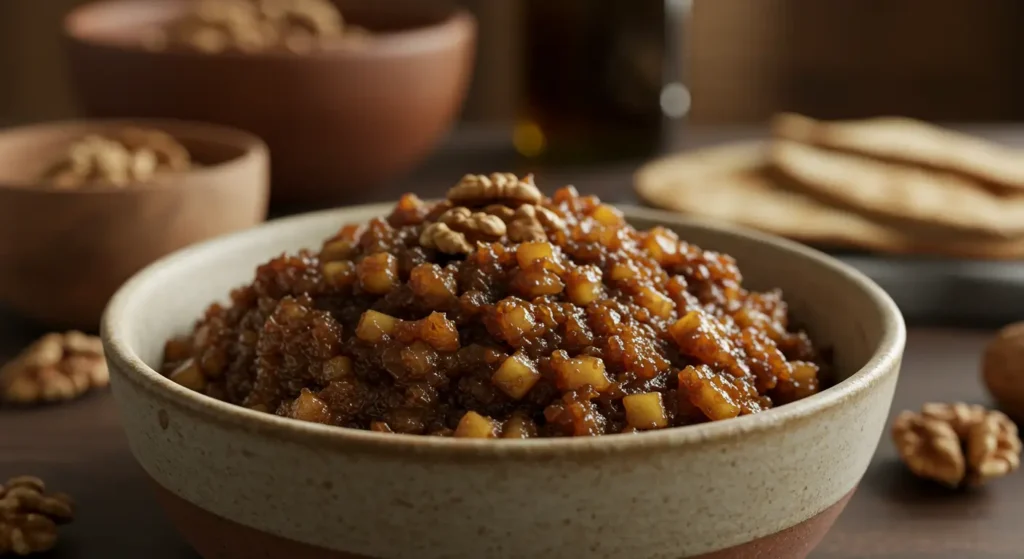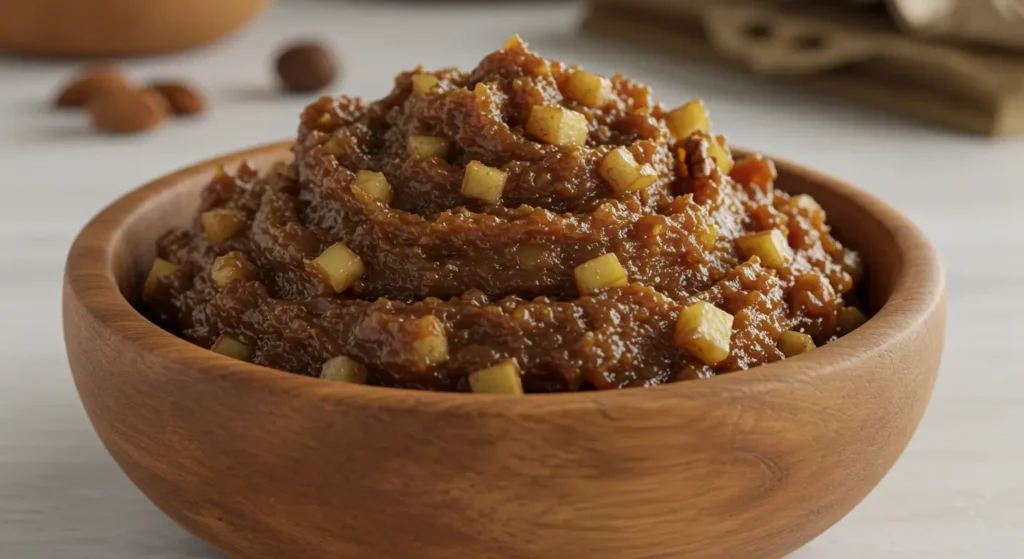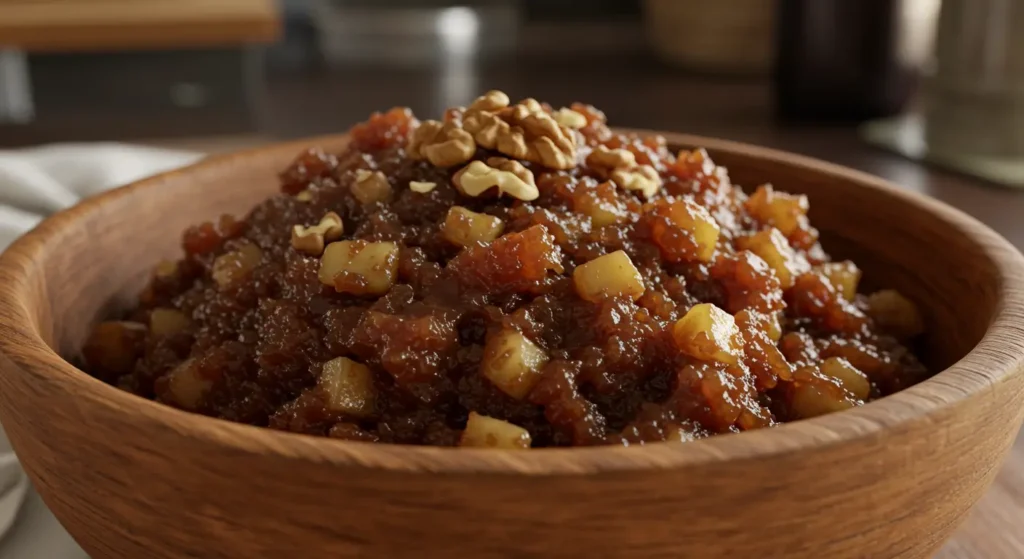Heavenly Homemade Charoset Without Wine
Table of Contents
Passover charoset is a cherished tradition, but what if wine isn’t part of your celebration? This homemade charoset recipe is a flavorful alternative that keeps the holiday spirit alive. It uses fruits, nuts, and spices to create a sweet, symbolic spread without wine. It’s perfect for Seders or any festive meal, fitting for those with dietary needs or preferences.
Key Takeaways
- Enjoy Passover charoset without wine using fresh ingredients like apples, dates, and cinnamon.
- Adaptable for dietary needs, such as vegan or alcohol-free diets.
- Simple steps make it easy to prepare for large gatherings or small families.
- Highlights the dish’s symbolic meaning while offering a modern twist.
- Perfect for pairing with matzo or as a standalone Seder component.
Introduction to This Unique Passover Charoset Recipe
Charoset is a key part of Passover seders. It mixes fruit, nuts, and spices for a sweet taste of Jewish heritage. The wine-free charoset keeps tradition alive without wine. It’s perfect for modern kitchens that still want to honor ancient customs.
“Charoset’s texture mirrors the mortar of ancient Egypt, yet its flavors celebrate freedom,” explains Rabbi David Goldstein, a Passover culinary expert.
Understanding the Significance of Charoset
Every part of charoset has a special meaning. Apples remind us of the tree that saved Hebrew slaves. Cinnamon brings to mind the mortar from Exodus stories. Even without wine, its rich taste connects us to our ancestors.
The Role of Wine Substitutes in Passover Traditions
Choosing wine-free charoset doesn’t mean you’re giving up tradition. Grape juice, honey, or citrus juices can replace wine. These options keep the holiday’s spirit alive, showing how traditions can adapt.
- Health preferences or alcohol restrictions
- Cultural variations from Ashkenazi to Sephardic practices
- Ease of preparation for large gatherings
The wine-free charoset shows how traditions can evolve. Its sweetness connects us to our past, making every bite special.
Ingredients Spotlight: Fresh and Traditional Choices
Every bite of your traditional Passover recipe starts with quality ingredients. Apples, dates, and figs form the sweet base. Walnuts and pistachios add crunch. These elements mirror ancient customs, grounding your dish in history.
- Fruits: Apples provide natural sweetness. Pomegranate seeds or dates add depth, depending on regional preferences.
- Nuts: Toasted walnuts or almonds balance texture. The nuts bring everything together with a rich flavor, even without using wine.
- Spices: Cinnamon and honey create warmth. Some families use ginger for a subtle kick, staying true to ancestral methods.

“Charoset ingredients reflect the mortar of Egyptian slavery—each piece tells a story,” says a Kosher culinary expert.
Focus on freshness: ripe fruits ensure natural juiciness. Use whole spices instead of pre-ground to maximize aroma. Experiment with ratios to match your family’s taste. This traditional Passover recipe thrives on balance—no single flavor should overpower the rest.
Step-by-Step Preparation Process
Starting your homemade charoset is all about careful prep. Follow these easy steps to make sure every part of your dish is perfect.
Prepping the Fruits and Nuts
- Wash apples, dates, and pears well under cool water.
- Peel and chop them into ½-inch cubes for a uniform texture.
- Toast nuts like walnuts or pecans in a dry skillet until they smell great, then chop them coarsely.
Blending Flavors for the Perfect Mix
Combine the diced fruits and nuts in a bowl. Add honey or applesauce to hold it all together. Taste it and add more sweetness with cinnamon or a bit of lemon juice if needed. For a smoother mix, pulse the ingredients in a food processor briefly. Just until they still have some chunkiness.
Serving Suggestions for a Memorable Meal
| Option | How To | Pairing Tip |
|---|---|---|
| Traditional | Layer with matzo during the Seder. | Serve with bitter herbs to balance flavors. |
| Modern Twist | Shape into balls for a modern appetizer. | Pair with spiced roasted chicken. |
Your homemade charoset can be tailored to your taste. Try adding dried apricots or coconut for something different. Show it off as the star of your Passover table.

Exploring charoset recipe without wine: Benefits and Creative Variations
Making charoset without wine makes it an easy Passover treat for everyone. It’s flexible and still honors tradition. You can adjust the flavors to your liking.
Health and Dietary Benefits Without Wine
Without wine, the recipe is perfect for kids or those who don’t drink. It also has less sugar if you use fresh fruits. It’s vegan-friendly if you replace honey with maple syrup.
It’s also great for those with gluten or nut allergies. Everyone can enjoy it.
- Lower sugar: Use unsweetened applesauce or less honey.
- Vegan-friendly: Substitute honey with agave or coconut nectar.
- Allergy adjustments: Swap nuts for sunflower seeds or coconut flakes.
Seasonal and Regional Variations
Make your charoset with what’s in season. Try strawberries or rhubarb in spring. For fall, add pears or cinnamon.
Try different flavors from around the world:
- Mediterranean: Add orange zest and pistachios.
- North African: Mix in dates and cardamom.
- Modern take: Blend with dried cranberries and ginger.
These changes keep the easy Passover treat fresh. They stay true to its roots. Try new things and reflect your heritage!
Tips for Perfecting Your Passover Charoset
Making great charoset depends on achieving the right texture and flavor balance. Here are some tips to make your recipe shine:
- Adjust sweetness gradually. Taste as you mix in dried fruits to avoid too much sweetness. Begin by adding a little honey or sugar, then adjust to taste.
- Toast nuts lightly for extra crunch. Walnuts or almonds add depth without the acidity of wine.
- Try adding a splash of citrus. Orange or lemon juice brightens the mix, making the charoset’s natural tartness pop.

| Storage Method | Lasts For | Best For |
|---|---|---|
| Refrigerated airtight | 3-5 days | Weeknight meals |
| Frozen in portions | 2-3 months | Large gatherings |
| Room temp (unrefrigerated) | 2 hours max | Seder plate setup |
Pro tip: Layer ingredients in a glass dish for a stunning Seder presentation. Don’t overmix to keep fruit chunks visible. For those with nut allergies, almond butter is a great substitute. It keeps the charoset’s flavor without wine and is safe for nut allergies.
Conclusion
Passover traditions mix old and new, and your charoset recipe is a great example. By leaving out wine, you can try creative charoset variations. This way, you honor the past while enjoying today’s flavors. Whether you like tart apples or sweet dates, you can make the dish your own. This lets you match the flavors to your family’s taste.
Trying out creative charoset variations makes your Seder special. Add cinnamon for warmth or walnuts for crunch. These small changes show your personal touch. This keeps traditions alive and shows that old dishes can change. They can still keep their essence.
Every bite of charoset tells a story. When you mix fruits and spices, you connect with Passover’s past. Share your unique charoset to make it your own. Happy Passover!
FAQ
What is charoset, and why is it significant during Passover?
Charoset is a traditional Jewish dish. It’s made from fruits, nuts, and spices. It symbolizes the mortar used by the Israelites in Egypt. It represents the sweetness of freedom. Charoset is a key part of the Passover Seder plate.
Can I substitute other ingredients in the charoset recipe?
Yes, you can make charoset your own. Try different fruits, nuts, or sweeteners. For a nut-free version, use seeds like pumpkin or sunflower seeds.
What are the benefits of making charoset without wine?
Making charoset without wine is great for guests with dietary restrictions. It keeps the dish sweet from fruits and spices. It’s also a healthier choice for those who don’t drink alcohol.
Are there any creative variations for charoset I can try?
Absolutely! Try using seasonal fruits like apples in fall or cherries in summer. Add spices like nutmeg and ginger. Explore regional flavors by adding dates or figs.
How should I store leftover charoset?
Store leftover charoset in an airtight container in the fridge. It lasts 5 to 7 days. The flavors get better with time.
What are some serving suggestions for charoset during Passover?
Serve charoset with matzo, as a yogurt topping, or in desserts. Use a traditional bowl or the Seder plate for presentation.
Is charoset gluten-free?
Yes, charoset is gluten-free. It’s made from fruits, nuts, and spices. Just check that any added sweeteners are gluten-free too.

